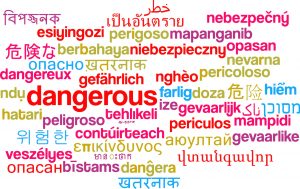If you’re in the Medical field, accurate translation is your top priority. Learn from Shy Avni, co-founder of Net-Translators, what you need to do to get great translations for Medical.
In order for medical companies to sell their products outside of the U.S., they need to translate content for all kinds of different users and purposes, including clinical trial paperwork, certifications, studies, product instructions and more. A company’s website is a critical marketing and technical resource since it’s usually the first point of contact that a customer has to a business. The website contains not only marketing copy, but also content that’s required to be translated such as instruction manuals, guides, videos and more for patients, doctors and medical facilities. The specific requirements are defined by each country’s governing agency and the different types of content, number of official languages and the audience type all factor into what’s required. Plus, regulations are constantly changing, so it’s not a straightforward process.
On top of that, high-quality translations are required in the medical industry. If you have errors in non-medical content, like a mistake in a Greek translation of a hotel description, the error may annoy a customer, which of course isn’t a good customer experience, but nothing will come from it. However, there’s no room for error in medical translations because:
- The content could be a matter of life and death
- The content could affect people’s safety
- A mistake could end up in a lawsuit
So how can you make sure that translations are accurate? In this article, we’ll describe some best practices to follow to help ensure that your website translation project has the best possible outcome.
Follow a Thorough Website Localization Process
Just like anything else, it takes time and a solid, thorough process to make a quality product. In an article entitled The 16 Steps of Website Localization and Translation, I walk readers through the entire process in detail, but here’s a snapshot of what’s needed.
Prepare for the Translation
The localization process should begin during the website design / development stage to identify any design-related issues that could affect localization. Internationalization is the process of generalizing a website so that it can be easily adapted for the target languages and locales. A pseudo translation, which is the process of emulating the target language using the same characters as the actual translations, should also be conducted in order to see if there are any coding errors that would affect the translation. Preparing a glossary of commonly-used product / service, company and industry terminology, which will be used throughout the translation, is critical to establishing a proper localization infrastructure.
Translation
Once a glossary is established, the translation company adds it to a translation memory (TM), which is a database of previously-translated content. The translation company will pre-populate all the glossary terms, as well as all the content in the TM, to the project so that the translator has a foundation of content. These tools make it faster for the translators to do their jobs while bringing consistency to the content.
After the translation, there should be rounds of proofreading, quality assurance testing and review by in-country reviewers (ICRs). Each one of these steps looks for different things to improve the quality of the translation.
Delivery
When the files are ready, the translation company delivers them to the client. Some website translation management systems connect directly with your website. For example, the WordPress Multilingual Connector solution, which is called WPML Translation Management (our company is a proud partner of this solution), is a plugin that allows users to quickly start a translation project from a website without having to send files back and forth. When the translations are complete, the user can have the translations delivered automatically or the user can manually get them. There are also proxy solutions, such as Net-Proxy, which track changes on the English website automatically without the need to notify the translation company. The translators are able to see the text in context while translating, which improves the efficiency of the translation.
Measure the Translation Company’s Quality Process
As we’ve mentioned, accuracy is critical for medical translations. A translation company should have a traceable quality process with defined standards, procedures, service levels, monitoring and continuous improvement processes. Quality can be difficult to measure since something that’s important to one company may not be as important to another. In addition:
- People can let their subjectivity through, so something may not really be “wrong.”
- There may be factors outside the translation, such as a rushed timeline or not enough reference information, which can affect the work.
- There may be expectation and perception differences between you and the translation company.
Therefore, it’s important to work with a translation company to define a quality plan that takes your company’s needs into account. The process should follow a repeatable, objective and accurate methodology to measure quality. Based on the documented findings, you can then take steps to improve the quality.
Use Specialized Medical Translators
Using professional, in-country translators with a medical background and years of experience translating medical content is essential for getting accurate, high-quality translations. If there’s a specific medical focus, the translators should have that specialty. There’s so much terminology for so many different types of medical specialties that it truly requires translators with medical expertise or else you could get a lot of errors.
In addition to expert translators, a medical translation company should have an experienced team including a project manager, internationalization and localization engineers, medical industry experts, IT and web specialists, multilingual QA testers and proofreaders.
Check the Translation Company’s ISO Certifications
There are so many translation companies and many aren’t equipped to do medical translations because of their complexity. Companies who don’t specialize in medical translations may try to convince you that they can do the work, but if they don’t specialize in it, you’re going to get low-quality translations. And in the medical industry, low-quality translations aren’t acceptable.
One way to determine how committed a translation company is to medical translations is to see what kind of ISO certifications they have. ISO sets rigorous standards, so if a company has ISO certifications, they care about quality. Here are three important ISO standards for a translation company:
- ISO 9001:2015 is a general quality management standard that provides requirements for companies to follow regarding quality practices.
- ISO 17100:2015 Is a quality standard for translation providers. It’s similar to ISO 9001: 2015 except that it’s tailored to translation companies, so it provides requirements for things like processes, resources and other things necessary to provide quality translations.
- ISO 13485:2016 is a quality standard for businesses that provide medical devices and related services. It extends to suppliers, such as translation companies. In order to get this certification, a translation company must have at least 50% of their business connected to medical devices, so if a company has this certification, it shows a huge commitment to the medical device industry.
So before you select a medical translation and localization vendor, check to see if they have these important ISO certifications.
You can also ask the translation provider to provide you with a list of their customers who are in the medical industry. You want to select a translation company with proven medical localization experience.
Conclusion
High-quality translations are a must-have, not a nice-to-have, and they require a translation company that specializes in medical translations. They certainly won’t come cheaply, and if you do receive a low-cost proposal, it probably means that some steps are missing in the process and / or the translators aren’t qualified or don’t live in the target country. It’s important to ask your translation service provider about their process, including the quality process, as well as their translators and what ISO certifications they have.
About the Author

Under Shy’s leadership Net-Translators has become a leading localization company. The company specializes in professional human translations for a wide variety of industries and services customers on 5 continents and in more than 60 languages. Certified with multiple international standards, including: ISO 9001:2008, ISO 13485:2003 (for medical devices) and ISO 17100 (Requirements for Translation Services), Net-Translators is committed to helping customers build their international reputation.
Shy is available to connect on LinkedIn, or via their website.

